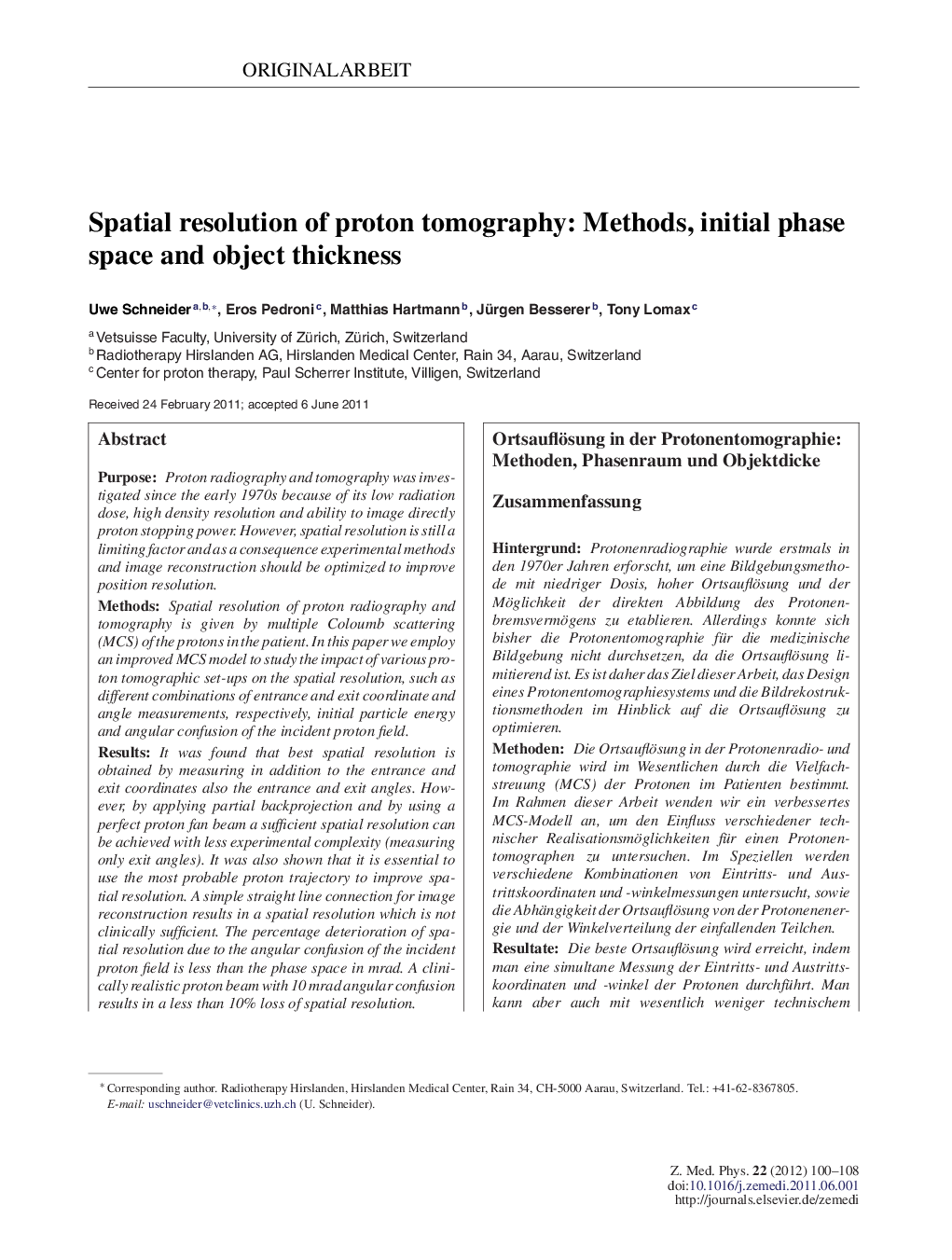| کد مقاله | کد نشریه | سال انتشار | مقاله انگلیسی | نسخه تمام متن |
|---|---|---|---|---|
| 1888116 | 1043661 | 2012 | 9 صفحه PDF | دانلود رایگان |

PurposeProton radiography and tomography was investigated since the early 1970s because of its low radiation dose, high density resolution and ability to image directly proton stopping power. However, spatial resolution is still a limiting factor and as a consequence experimental methods and image reconstruction should be optimized to improve position resolution.MethodsSpatial resolution of proton radiography and tomography is given by multiple Coloumb scattering (MCS) of the protons in the patient. In this paper we employ an improved MCS model to study the impact of various proton tomographic set-ups on the spatial resolution, such as different combinations of entrance and exit coordinate and angle measurements, respectively, initial particle energy and angular confusion of the incident proton field.ResultsIt was found that best spatial resolution is obtained by measuring in addition to the entrance and exit coordinates also the entrance and exit angles. However, by applying partial backprojection and by using a perfect proton fan beam a sufficient spatial resolution can be achieved with less experimental complexity (measuring only exit angles). It was also shown that it is essential to use the most probable proton trajectory to improve spatial resolution. A simple straight line connection for image reconstruction results in a spatial resolution which is not clinically sufficient. The percentage deterioration of spatial resolution due to the angular confusion of the incident proton field is less than the phase space in mrad. A clinically realistic proton beam with 10 mrad angular confusion results in a less than 10% loss of spatial resolution.ConclusionsClinically sufficient spatial resolution can be either achieved with a full measurement of entrance and exit coordinates and angles, but also by using a fan beam with small angular confusion and an exit angle measurement. It is necessary to use the most probable proton path for image reconstruction. A simple straight line connection is in general not sufficient. Increasing proton energy improves spatial resolution of an object of constant size. This should be considered in the design of proton therapy facilities.
ZusammenfassungHintergrundProtonenradiographie wurde erstmals in den 1970er Jahren erforscht, um eine Bildgebungsmethode mit niedriger Dosis, hoher Ortsauflösung und der Möglichkeit der direkten Abbildung des Protonenbremsvermögens zu etablieren. Allerdings konnte sich bisher die Protonentomographie für die medizinische Bildgebung nicht durchsetzen, da die Ortsauflösung limitierend ist. Es ist daher das Ziel dieser Arbeit, das Design eines Protonentomographiesystems und die Bildrekostruktionsmethoden im Hinblick auf die Ortsauflösung zu optimieren.MethodenDie Ortsauflösung in der Protonenradio- und tomographie wird im Wesentlichen durch die Vielfachstreuung (MCS) der Protonen im Patienten bestimmt. Im Rahmen dieser Arbeit wenden wir ein verbessertes MCS-Modell an, um den Einfluss verschiedener technischer Realisationsmöglichkeiten für einen Protonentomographen zu untersuchen. Im Speziellen werden verschiedene Kombinationen von Eintritts- und Austrittskoordinaten und -winkelmessungen untersucht, sowie die Abhängigkeit der Ortsauflösung von der Protonenenergie und der Winkelverteilung der einfallenden Teilchen.ResultateDie beste Ortsauflösung wird erreicht, indem man eine simultane Messung der Eintritts- und Austritts- koordinaten und -winkel der Protonen durchführt. Man kann aber auch mit wesentlich weniger technischem Aufwand eine ähnlich gute Ortsauflösung erreichen, wenn man mit einem perfekten Protonenfächerstrahl arbeitet und einen partiellen Rekonstruktionsalgorithmus anwendet (alleinige Messung der Austrittswinkel). Es wurde im Rahmen dieser Arbeit auch gezeigt, dass es zwingend notwendig ist, die gemittelte Protonentrajektorie zur Bildrekonstruktion zu verwenden um optimale Ortsauflösung zu erhalten. Wird nur eine gerade Verbindung zwischen Protoneneintritts- und -austrittskoordinate gewählt, ist die resultierende Ortsauflösung für klinische Anwendungen nicht ausreichend. Es konnte gezeigt werden, dass die Verschlechterung der Ortsauflösung durch die Winkelverteilung der Protonen (in %) immer kleiner ist als deren Phasenraum (in mrad). Ein typischer klinischer Protonenstahl mit 10 mrad Winkelverteilung resultiert in einer Verschlechterung der Ortsauflösung um 10%.ZusammenfassungWenn man Protonentomographien mit realistischer Ortsauflösung aufnehmen will, muss man entweder die Ein- und Austrittskoordinaten und -winkel für jedes Proton messen, oder einen Protonenfächerstrahl mit kleiner Winkelverteilung verwenden, bei dem man nur den Austrittswinkel misst. Für die Bildrekonstruktion ist es wichtig die mittlere Protonentrajektorie zu verwenden und nicht nur eine einfache Gerade. Die Verwendung höherer Protonenenergien resultiert in einer verbesserten Ortsauflösung (bei konstanter Objektdicke).
Journal: Zeitschrift für Medizinische Physik - Volume 22, Issue 2, June 2012, Pages 100–108